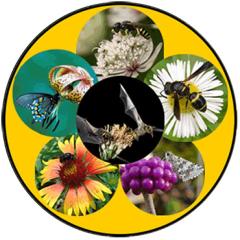Who Are the Pollinators?

Animal pollinators play a crucial role in flowering plant reproduction and in the production of most fruits and vegetables. Most plants require the assistance of pollinators to produce seeds and fruit. About 80% of all flowering plants and over three-quarters of the staple crop plants that feed humankind rely on animal pollinators.
Pollinators visit flowers in search of food, mates, shelter and nest-building materials. The energy that powers pollinator growth, metamorphosis, flight and reproduction comes from sugars in nectar, and the proteins, fats, vitamins and minerals from pollen grains.
The secret bond of the partnership is that neither plant nor pollinator populations can exist in isolation – should one disappear, the other is one generation away from disaster.
Learn more about these very important pollinators and the flowers they visit:
Bees play a critical role in ecosystem health and sustainability across the globe. They pollinate flowers, trees and other plants that in turn provide food and habitat for other creatures. Their role in pollinating agricultural crops is invaluable. But recently scientists have observed that many pollinating species, including wild bees, are declining in range or abundance and the Midwest United States has among the lowest predicted bee abundance.
North American Pollinator Protection Campaign
"Our Future Flies on the Wings of Pollinators"
This poster is made available by the U.S. Forest Service, U.S. Fish and Wildlife Service, Bureau of Land Management, Natural Resources Conservation Service, U.S. Botanical Gardens, and the NAPPC (North American Pollinator Protection Campaign).
Artist: Paul Mirocha


